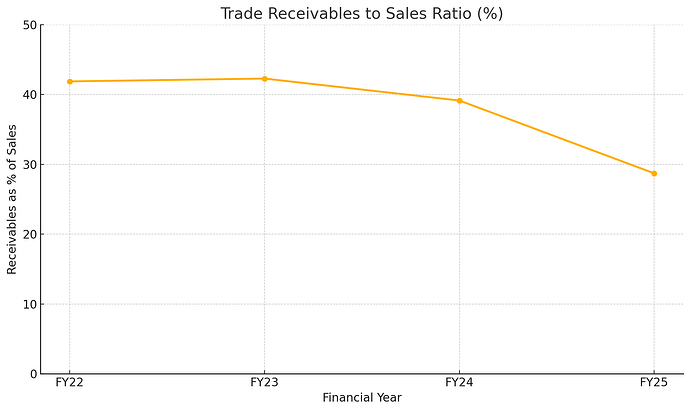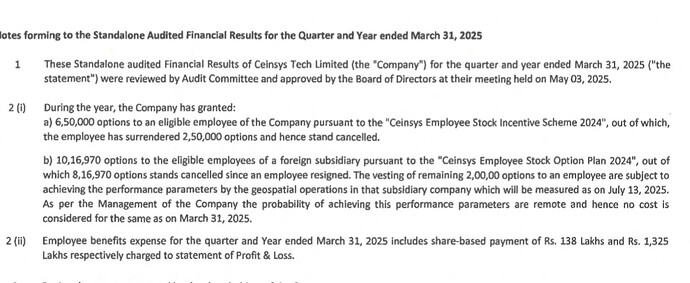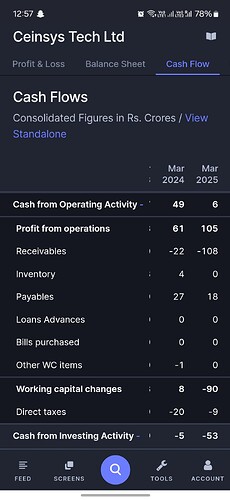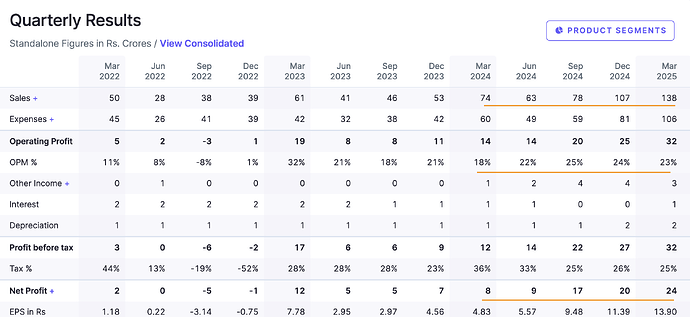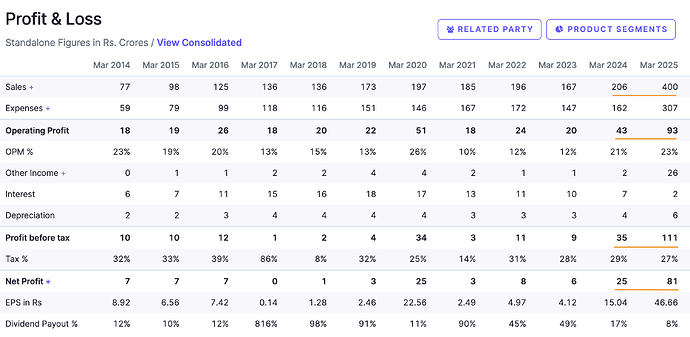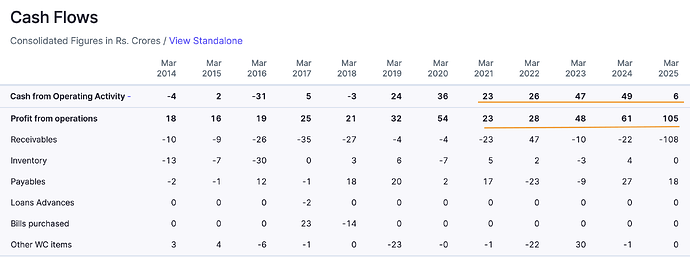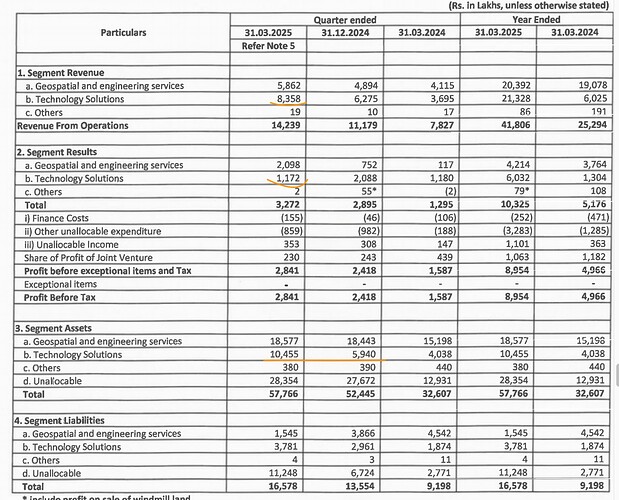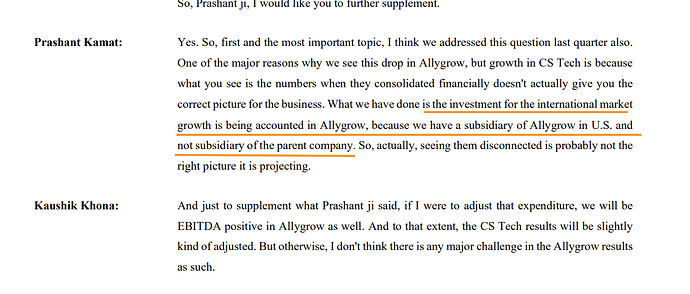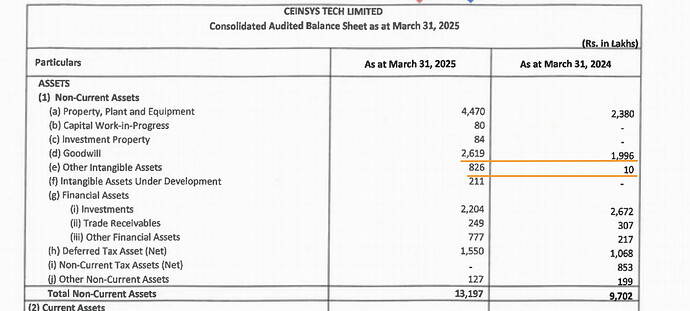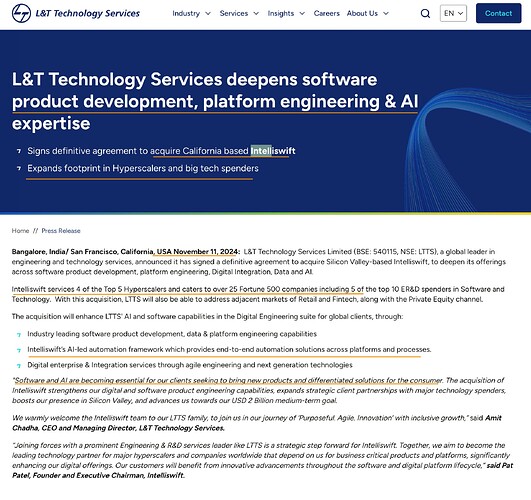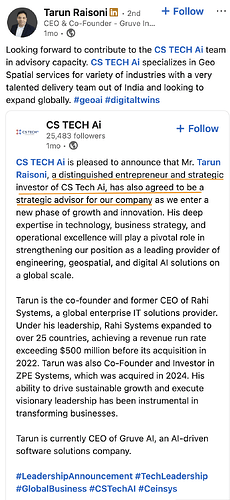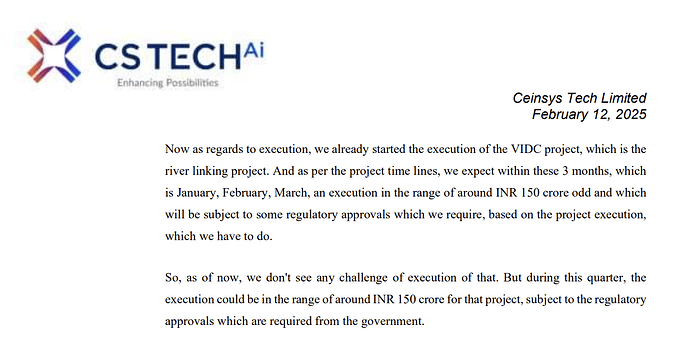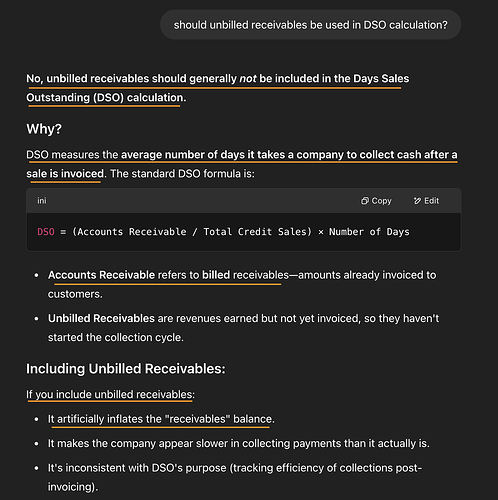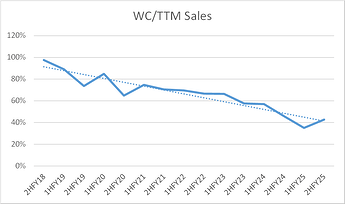Though receivables look high for FY 25, but if we compare it with sales, it has significantly improved compared to previous years
As you correctly pointed out, the 8 lakh options vested to Rashi Mehta expired worthlessly and the company expects the remaining to expire too by July.
Does that mean Rashi and her husband could not add value or didn’t find value to put in 150cr for these options? The fact that acquisition money is still not utilized means they are unable to find a good company and right value, however the longer this drags, can this have impact on growth prospects?
The receivables has increased a lot. This has led to short term borrowings of 39.87Crs. I doubt as the business grows the receivables increase but YoY 391% and sales growth 65% is concerning. If I’m missing out somewhere the community can help.
Their exercise price was higher than the current market price therefore they didn’t exercise the options as they were worthless.
Several factors could contribute to this sharp rise in receivables:
- Large Government Contracts: Ceinsys Tech has secured substantial government projects, such as the River Linking Project and IoT-based Water & Sanitation Project in Maharashtra, valued at ₹381.18 crore and ₹331.6 crore respectively. Government contracts often have longer payment cycles, which can lead to increased receivables.
- Project-Based Revenue Recognition: The company may recognize revenue based on project milestones, leading to receivables accumulating before cash is received.
8,16,970 Options stands cancelled as an employee has resigned as per the notes.
Rashi Mehta was granted 8,16,970 stock options.
Does it mean that Rashi Mehta has resigned?
Most likely she has resigned if we connect the dots.
The results are good and lets start with the mandatory snapshot
The thing to note is the actual growth is even better when we look at just the standalone
86% topline growth, 129% EBIDT and 300% PAT growth. This is the actual growth from the India business. Growth is actually muted at the consol level and is looking great despite that - we will explore into the reasons why this might be, later in this post.
At a yearly level, on standalone the topline has nearly doubled and bottomline has more than tripled (324%) which is phenomenal, considering several large projects in the standalone business are yet to contribute.
It doesn’t look like there was a big contribution from the river linking project which should likely show up in Q1/Q2 (150 Cr initial bit) and rest probably in H2 FY26 making FY26 a pretty loaded year for CS Tech Ai (whatever!). The management had mentioned that it was waiting for approval for river linking project - I doubt if it came in time.
Moving next to the CFO, this time there’s a big drop as compared to previous years. (Note, a drop in CFO is 1 random year is not a concern. CFO/EBITDA conversion should be done over longer periods. A -ve or poor conversion over 10 yrs, is definitely a concern. So we should know when and how to use the tools and not use any one metric as a hammer)
Generally when this happens, there’s a lot of money locked up in working capital. Let’s see if that’s the case
Turns out receivables days has actually improved quite a lot in FY25 and is down to just 104 days. So its not the WC (before we point fingers at govt and JJM issues)
The other thing to note is the management mentioned that CFO for 9m was 124 Cr in the Feb concall. So clearly its the execution in Q4 that has contributed to the drop in CFO. My initial guess is that the river linking project execution has started but revenue cannot yet to recognised and so it should show up as unbilled revenues. Here the managed clarifies in Nov concall
There’s a ~70 Cr jump in unbilled revenues which is the likely cause for the reduction in cash flows (or the major cause based on standalone CFO - what’s happening at the consol level that we discuss later contributes to the rest)
The same can be seen in the Technology solutions (which is where the river-linking project will fall) margins as well. My guess is the employee cost is expensed out in Q4 while the revenue is not yet recognised (which means margins might be good in Q1/Q2 but we shouldn’t extrapolate that and should look on a rolling 12mo basis only for businesses like this - good or bad). The segment assets going up as well confirms that the unbilled revenue jump is mostly from the river-linking project.
Lets now look at what’s causing the consol level hit almost every quarter now. There’s a 4 Cr contribution at consol level for which the employee cost alone has gone up by 8 Cr for just Q4. For overall year, the diff between consol and standalone topline is 18 Cr for which there’s a 27 Cr employee cost. Does this mean the subsidiary is loss-making? Again, this was discussed in the last call
It looks like whatever growth investments are happening in Technology Associates is yet to contribute to growth. However, there are some intangibles in the BS. I am not sure what business development is happening in the US but definitely something is
The company is expensing these things instead of capitalising which is good. What this pertains to, however is unknown but I have some speculations.
That takes us to the next part of the puzzle in the results doc .
It looks like Rashi Mehta has resigned and has given up the options. Also, it looks like Prashant Kamat has also surrendered a part of the options granted to him last year.
My guess is Prashant Kamat won’t be CEO next year and Surej will likely take over.
So this gives heft to my hunch that whatever is happening in the US subsidiary is going to be big for the company - in pretty much the same way that AllyGrow acquisition was back in 2021.
Very recently AllyGrow got amalgamated (or got NCLT approval for it) with parent Ceinsys. This I think marks a completion of the acquisition. It is likely that Kamat was given options as additional payout for the acquisition since it was acquired for very cheap on the surface. Now I think he has fulfilled his commitments and could be getting a move on (Or might stay on as vice chairman) - this is entirely my speculation.
Since the company is on a growth path with the newly planned acquisitions, the board likely thinks (could be Tarun Raisoni’s decision as well, as a big contributor to funds) Surej might be better suited for the next leg of planned growth.
While Kamat came in from AllyGrow which was doing ~$10m revenue, Surej is coming from Intelliswift (was its CEO) that has ~$100m in revenue and was acquired by LTTS recently. So there’s definitely chops to lead the next leg of growth.
This is what LTTS thinks of Surej’s company
Surej has firm roots in product development, data centers, hyperscalers AI and automation from his previous company and my guess is, he is a reco from Tarun (being a silicon valley guy himself). My hopes are up with whatever they are planning to do. My guess is that it can’t be far away. Maybe there’s a deeper reason for the “AI” bit in company name - at least hiring someone like Surej gives me hope.
The other thing on Rashi’s resignation - I think this was done since Tarun himself as come onboard as advisor (I recently found that Tarun has sold not 1 but 2 companies for big payouts - $270m for Rahi from Wesco and $295m for ZPE from Legrand)
And getting Phaneesh Murthy (global sales head of Infy between '95-'02) as additional director onto the board should also strengthen the tech direction of the company. Turns out Phaneesh Murthy was also on the board of Intelliswift when Surej came onboard as CEO before the LTTS acquisition. All these changes to me point to a company that is thinking way bigger than it is. Lets see how it plays out.
Valuation:
I think valuing the business based on current consol would be incorrect due to the expensing of new business venture which is infact an investment. The way I think about these sort of businesses where there’s a part that’s dragging the overall is based on Kahneman’s dinner set analogy - which is essentially looking at standalone basis and valuing that - At 81 Cr PAT, the standalone business is trading at 34x TTM, 20x 1 yr fwd and ~15x 2yrs fwd - without the optionality of whatever is happening with the new businesses acquired/built.
Disc: Invested from 260 levels. I might be very biased here. Please do your own research
I was waiting for your post ![]()
And it seems I am the only person who is questioning and doubting the numbers here.
How did you assume/figure out that:
there was a big contribution from the river linking project which should likely show up in Q1/Q2 (150 Cr initial bit) and rest probably in H2 FY26 making FY26 a pretty loaded year for CS Tech Ai (whatever!)"
My only biggest concern is around standalone employee benefits.
A drop of nearly 5 crores in employee expenses for a high growth company? I am unable to make any wild guess how could this is even possible. Added to the above, they also added a lot of employees in Q4.
I would have definitely cashed out some part had there is atleast some tiny space in the current market scenario for parking the money.
If river-linking was included in full, that alone should have contributed 150 Cr (transcript)
Notes to account from Q3 result. The 5 Cr difference comes from the ESOP accounting which was there in Q3 and not in Q4. I can’t check EPFO (its down) to see what’s diff in employee count between Q3 and Q4 - but my guess is Q3 itself hiring was done for river-linking project (if execution was to start in Q4)
Looks like screener @ayushmit has made a mistake in calculating debtor/receivable days -
Trade Receivables (Billed): ₹11,957 lakh
Trade Receivables (Unbilled): ₹13,376 lakh
Total Receivables: ₹25,333 lakh
Revenue from Operations (FY25): ₹41,806 lakh
Formula:
Receivable Days = (Total Receivables / Revenue from Operations) × 365
Calculation:
Receivable Days = (25333 / 41806) × 365 ≈ 221.4 days
last year they were even higher at 235 days. These are exceptionally high trade receivables and some of them are bound to go bad and will hit the profit and loss soon. We should ask the management where this money is stuck and how much of if they expect to recover?
A question like this could be asked -
As of FY25, consolidated trade receivables stand at ₹253 Cr, including over ₹133 Cr in unbilled revenue — representing more than 60% of the company’s annual revenue. Could you please elaborate on the timeline for realization of these receivables? Can you share how much of these receivables are from central or state government clients?
What is Unbilled Revenue?
Unbilled revenue is revenue that a company has earned by delivering goods or services to a customer but has not yet invoiced or billed the customer for. It arises when a company recognizes revenue based on the completion of performance obligations (as per the contract) but has not issued an invoice due to timing, billing schedules, or project milestones.
Does Unbilled Revenue Reflect in the Revenue of the Company?
Yes, unbilled revenue is included in the company’s revenue in the Profit and Loss Statement.
Disclosure - Invested.
The difference you are getting is because you are including the “Unbilled receivables”. Unbilled by definition isn’t yet invoiced and can’t be paid. Revenue recognition meanwhile is governed by accounting standards (Ind AS 115).
So including something like this in receivable days isn’t intuitively right because by defition its trying to measure how long a company takes to get paid after it raises invoices.
AI on the matter again
End of the day, these metrics should help us develop intuitions. Without those intuitions, numbers have no meaning. If “Unbilled receivables” were called “Contract Assets” which is the Ind As 115 definition, perhaps there would be less confusion.
Unbilled revenue: These revenues are basically where a company books the revenue based on the milestone of a project.
For example : As per contract you (Contractor) have to do billing on a monthly basis for the work done during month. So at the end of the month you can book the revenue based on terms of contract. At the start of next month you will have to submit the details of work done during the month to the authority who has awarded you the work (Say State or Central Govt) for validation. Once the work is validated by the Govt and also certified by third party appointed by the Govt , the Contractor can then bill the invoice and Unbilled revenue turns into receivable.
If the Unbilled revenue is large then it means that the contractor has done the work and booked the revenue as per the contract, however the work done claimed by the contractor has not been approved by the Govt/ certified by third party. This may happen due to quality of work done which may not be as per the terms of contractor or they may be some objections of the government or third party. Overall conclusion is that disproportionate increase in Unbilled revenue is a negative signal and needs to be monitored closely.
Unbilled revenue normally should not be old more then 30 days in normal circumstances and generally this is the time within which the work done during the period gets verified and certified and ready for billing.
Disclosure : Not invested.
Exactly, What does trade receivable as a metric indicate?
Trade receivable indicate the amount shown in revenue which is not yet received by the company. It simply does not matter if it is billed or unbilled.
Trade receivable intuitively indicate to an observer that look the company has shown this much revenue but have not received this money be careful while you look for year-on-year revenue growth crooks could be at play. ![]()
Grok on unbilled receivable -
ChatGPT on unbilled receivable -
In other words project is not cash neutral. If it was cash neutral unbilled receivables would have been adjusted against stage payments received.
This is a good point. We should not get bogged down by definitions and standards, and risk losing sight of the real thing we want to measure.
The weak link of this company and the main anti-thesis is working capital, working capital, working capital. Much as expected when the government is a client, for this company as well, the working capital picture does not look great.
Whether calling it debtors or some other name, I would calculate my money stuck as you show @Gaurav_Agarwal - because that is what it is. Money stuck.
I don’t like the payables picture also - two years plus ![]()
The company’s money comes in super slow through the government sludge, and as a domino effect, the company’s vendors also are forced to be super patient. Some will say this shows the power of the company - they can delay payments to their vendors. But I have seen that this is not a good situation. Everyone in the value chain gasping due to working capital crunch is not ideal.
The company might be successful in spite of all these. It’s not a company-specific problem. This problem is very common where the government is a large client. But such companies fall into my “avoid” pile. I have seen really good companies (good management, genuinely good skill set) struggle just because of having governments as key clients because of the working capital impact.
Example: VA Tech Wabag. Great sector and market (water), good management, good skill and talent. They have burnt their fingers on working capital, and have been trying to pivot to getting projects funded by donor agencies rather than governments - because they pay on time.
If invested in this company, I would be very alert to metrics and signs of stretched working capital - ones such as yours @Gaurav_Agarwal . Thank you for raising this.
Discl: Not invested, this company falls under my “avoid” pile
Some more metrics I’d learnt to watch (in addition to receivables and payables) in such companies are:
- Interest: Often, short term borrowings are taken to bridge the working capital requirements. So watching interest cost is useful. It may be calibrated vis-a-vis revenue, though I prefer interest cost dipping slightly as a % of revenue as the company grows, even though interest may go up in absolute terms. If interest as % of revenue rises, it calls for more investigation. For this company, interest seems in control, which is good
- On the balance sheet, watch borrowings, and also other liabilities. Borrowings are linked to the interest point above, they are often used to bridge working capital requirements. But even if those are in control, watching the growth of other liabilities can be instructive. There may be other desperate infusions, which may not show up as cleanly as borrowing/ interest. For this company, payables is a problem - they are squeezing their vendors. This liability has built up a lot. As I said in my prev post, while some may say that this shows the negotiating power the company has over its suppliers, I believe that the entire value chain gasping due to working capital crunch is not a good situation.
Will be interesting to see other useful metrics the forum might come up with to track performance on the working capital front.
Risks related to stretched working capital and reliance on Government contracts are well-known as well as well-discussed risks for this company. It is fair to assume that investors who have chosen to participate in this sector/company would have already taken these aspects into considerations before taking the plunge. If not, then such events are bound to spook sentiments.
Having said that, while the working capital data for this year-end looks worrying; an analysis over longer time period should allay some concerns.
I have looked at the working capital intensity over time by compiling semi-annual (HY) data for last 8 years. My opinion is that the increased working capital intensity is not a concern YET
Cash flow generation weakened after a long time
- Working capital intensity has led to negative CFO first time since Covid-19 (i.e., 1HFY21)
- Cumulative 2 years and 3 years CFO / PAT has abruptly gone down to 56% and 78%, which was way above 100% for quiet some time.
However, the overall working capital intensity continues to be on a declining trend
- More than 90% of the working capital is in [A] trade receivables, [B] unbilled revenues and [C] trade payables.
- Net working capital using these major heads [A+B-C] has been falling consistently as a percentage of sales. There is a meaningful H-o-H increase only in this 2HFY25, but Y-o-Y ratio is still down from 46% to 43%.
- Long-term fundamental investors may consider giving the management some benefit of doubt for showing improvement for 4 straight years and only report an uptick for one 6-month period.
On the positive side, the business has seen a meaningful shift in trajectory
- For the last 7 years, revenue in 1H has always been lower than previous year’s 2H. In FY25 however, 1HFY25 reported a sequential growth, i.e., it was higher than 2HFY24.
- Given this marked improvement in business momentum, it may be expected for companies in this sector to face higher working capital intensity during such times.
- One may want to note that whenever WC capital intensity did go up in the past, it was managed eventually. Not saying this will happen. Just that there is some precedence.
Possible conclusion (since you may have your own)
- An investor who has done the due diligence and (a) is comfortable with the corporate governance standards and (b) is fairly confident on the execution of large orders in the near term, may want to stay put. Current financial positions is very much in line with historical performance and the ongoing trend.
- However, the company has certainly taken a higher intermittent risk in accepting order(s) which have longer payment cycle. It might well be a calculated risk which could have other long-term benefits. Such increases in WC may be expected to coincide with meaningful increase in growth trajectory for companies in this sector. This is the inherent risk in this space.
- Investors may want to judge for themselves if the valuations at any point are reasonable enough for taking on this risk.
Disclosure:
- I am not invested in the stock. It falls in my “too-hard-for-me” bucket. I am still following the stock / sector for improving my understanding.
- I am not a SEBI registered advisor or analyst. This is not a recommendation.
- The above is purely my opinion. I wanted to share the data and my analysis with the community for improving our collective understanding.
- I have made many errors in the past when analyzing, forecasting and valuing businesses. Kindly rely on your own analysis while deciding the next course of action.
- Suggestions / feedback are welcome!
Ceinsys tech q4 fy25 con-call notes:
( this is not a full transcript, I might have missed few points and some of my notes might have errors, Please go thorough the recording for what exactly the company has discussed)
Allygrow fy25 contribution: 83 cr revenue, 10 cr profit.
Order book: 1197 cr (Technology solutions is 500 cr total and 400 is from water, and rest from other verticals, as on April 1st, 2025. Excluding Allygrow.
200-300 cr. order-book increase is the target, bidding for 300-400 cr.
280 crore from 2 projects are expected in next 1 month out of 300-400 bid done.
Average 18-20 months timeline for execution of orderbook.
Revenue Growth:
Will maintain current growth rate and target more. Will try to protect current margins and try to improve.
Esops cancelled:
Rashi resigned and hence not eligible for esops.
Exiting CEO doesn’t want to walk out with esops and hence cancelled and would be most likely given to new CEO.
Next year esop cost is Not finalised yet. Prashant Kamat might continue in advisory role.
M&A : Customer acquisition and competency acquisition is the key metric for acquisition that company is looking for.
No projects are getting delayed once it is awarded.
States where Ceinsys is interested in govt projects: MH, UP, MP, GJ, RJ urban dev, water.
Receivables: Are not increased, but high due to unbilled revenues.
Unbilled revenue: Might continue to remain around same lines as old UBR might be billed and new UBR is added as revenues are growing.
JJL: Reduction from govt not impacting the company.
UK FTA: No significant impact for the company.

